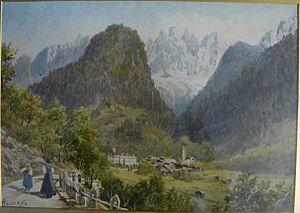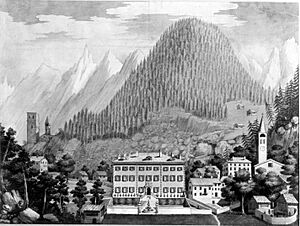Bondo, Switzerland facts for kids
Quick facts for kids
Bondo
|
||
|---|---|---|
|
||
| Country | Switzerland | |
| Canton | Graubünden | |
| District | Maloja | |
| Area | ||
| • Total | 26.26 km2 (10.14 sq mi) | |
| Elevation
(Church)
|
823 m (2,700 ft) | |
| Population | ||
| • Total | 204 | |
| • Density | 7.768/km2 (20.12/sq mi) | |
| Postal code |
7606
|
|
| Surrounded by | Castasegna, Novate Mezzola (IT-SO), Soglio, Stampa, Val Masino (IT-SO), Vicosoprano, Villa di Chiavenna (IT-SO) | |
Bondo is a charming village located in the beautiful Swiss canton of Grisons. It used to be its own municipality, but since 2010, it's part of a larger area called Bregaglia. Bondo is nestled in the Maloja district, close to the border with Italy.
Contents
Geography: Where Bondo Is Located
Bondo is found in a deep valley called Val Bregaglia, also known as Bergell in German. This valley is so deep that some parts of the village don't get much sunlight during winter. Imagine living in a place where the sun hides for months! The village sits south of the Mera River.
From Bondo, a smaller valley called Val Bondasca stretches up towards two impressive mountains: Piz Badile and Piz Cengalo. These peaks are part of the Bregaglia Range.
Besides Bondo itself, the area also includes a smaller village called Promontogno. High up on a rocky spot, you can see the old ruins of Castelmur. There are also a few other places that used to be settlements but are now empty.
In 2006, Bondo covered an area of about 28.2 square kilometers (about 10.9 square miles). A small part of this land (2.5%) was used for farming. A bigger part (37.6%) was covered by forests. Only a tiny bit (0.6%) had buildings or roads, and most of the land (59.3%) was made up of mountains, rivers, or glaciers.
On January 1, 2010, Bondo joined with four other villages – Castasegna, Soglio, Stampa, and Vicosoprano – to form the new municipality of Bregaglia.
History: A Look Back in Time
Long ago, under the Carolingian dynasty (a powerful family of rulers), Bondo was part of a region called Ministerium Bergallia. This area was linked to the early Bishops of Chur. Later, after the year 960, the Bishop owned it directly.
The valley church of S. Maria at Castelmur was first mentioned in records in 988. The village church for Bondo, S. Martino, was officially opened in 1250. During the High Middle Ages (a period from about 1000 to 1300 AD), Bondo was one of several villages known as di là dell'acqua, meaning 'across the water'. These villages were part of the Unterporta district.
In 1367, Bondo and the rest of Unterporta joined the League of God's House. This was a group of communities that came together for protection. The name Bondo was first written down in 1380. In German, it was sometimes called Bundth, and in Romansh, it was Buond.
In 1552, the Protestant Reformation arrived in Bondo. This was a time when many people changed their religious beliefs. During the 16th century, some people from Bondo moved to Italy or Eastern Europe to work as bakers or soldiers. This trend continued into the 20th century, with many people moving to other parts of Switzerland.
During the Thirty Years' War (a big conflict in Europe from 1618 to 1648), the area where Bondo is located faced a lot of trouble. In 1621, Spanish soldiers burned Bondo to the ground, destroying about 248 buildings. The village was then rebuilt with new central streets.
2017 Debris Flows: A Natural Event
In August 2017, Bondo experienced a series of debris flows. These are like fast-moving landslides made of mud, rocks, and water. They came down from the nearby mountain Piz Cengalo. The flows caused damage to many buildings and a bridge in Bondo.
Demographics: Who Lives in Bondo?

In 2008, Bondo had a population of 204 people. About 10.3% of them were not Swiss citizens. Over the ten years before 2008, the population slightly decreased.
In 2000, about 48.7% of the people were male and 51.3% were female. The age groups in 2000 were:
- Children (0-9 years old): 9.4%
- Teenagers (10-19 years old): 6.6%
- Young adults (20-29 years old): 8.8%
- Adults (30-59 years old): 39.2%
- Seniors (60-99 years old): 34.4%
In 2007, during the federal election, the most popular political party in Bondo was the SP, which got 37% of the votes.
Most adults in Bondo (around 63.8%) have finished high school or gone on to higher education, like university.
Bondo has a very low unemployment rate, at 0.61%. In 2005, there were 16 people working in farming, 22 in manufacturing, and 36 in services (like shops or hotels).
Here's how the population of Bondo has changed over time:
| year | population |
|---|---|
| 1803 | 235 |
| 1850 | 230 |
| 1900 | 304 |
| 1950 | 239 |
| 1960 | 254 |
| 2000 | 181 |
Languages: What Languages Are Spoken?
In 2000, most people in Bondo (77.3%) spoke Italian. German was the second most common language (19.3%), and Romansh was third (1.7%).
A long time ago, in 1900, almost everyone (92.76%) spoke Italian. By 1970, it was still very high at 95.65%. It wasn't until 1980 that a noticeable number of people started speaking German.
Here's a table showing the language changes:
| Languages | Census 1980 | Census 1990 | Census 2000 | |||
|---|---|---|---|---|---|---|
| Number | Percent | Number | Percent | Number | Percent | |
| German | 25 | 13.59% | 26 | 16.15% | 35 | 19.34% |
| Romansh | 1 | 0.54% | 0 | 0.00% | 3 | 1.66% |
| Italian | 155 | 84.24% | 133 | 82.61% | 140 | 77.35% |
| Population | 184 | 100% | 161 | 100% | 181 | 100% |
Architecture: Famous Buildings
The church of S. Maria in Castelmur was mostly rebuilt in the 1800s. However, it still has its old Romanesque bell tower. The S. Maria church in Bondo also has a Romanesque bell tower. This church was fixed up in the 1600s, but it still has beautiful old paintings from the late 1400s. The famous painter Varlin is buried in the nearby cemetery.
Other important buildings include the Casa Molinari, the Palazzo Scartazzini (built in 1690), the Palazzo Scartazzini am Platz (from 1763), and the Palazzo Salis. The Palazzo Salis was started in 1765 by Jerome de Salis-Soglio for his wife and finished by their son in 1774. It is still owned by the Count de Salis-Soglio family today. There are also some traditional stone buildings called crotti near Promontagno. In the 1900s, the painter Varlin captured the feeling of the village in his art.
Heritage Sites: Important Places
The old Castelmur fort, the church of S. Maria, and the Palazzo Salis are all very important historical sites in Switzerland. They are listed as heritage sites of national significance.
See also
 In Spanish: Bondo (Grisones) para niños
In Spanish: Bondo (Grisones) para niños









